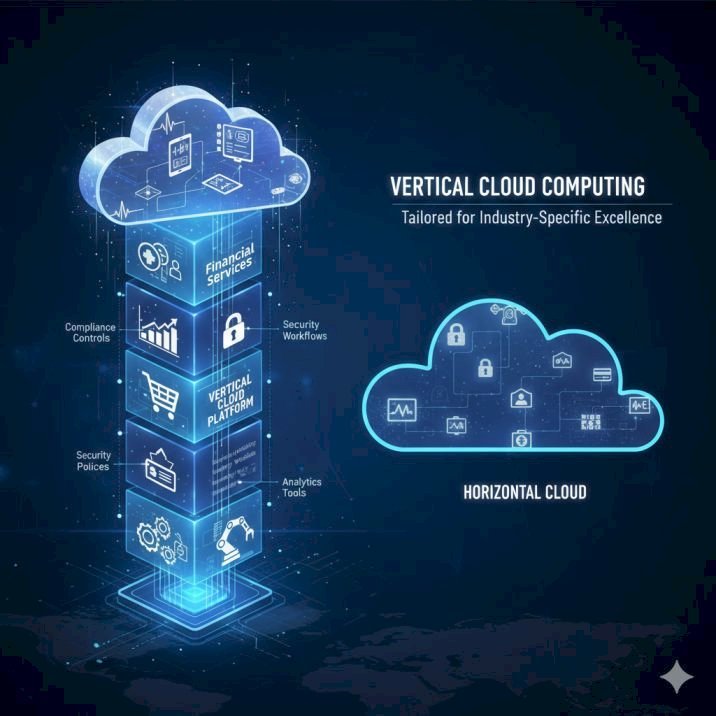Vertical Cloud Computing: Meaning, Benefits & Real Industry Use Cases
Discover what vertical cloud computing is, how it differs from horizontal cloud platforms, key benefits, challenges, and real industry use cases across sectors.

Cloud computing has transformed the digital landscape, providing companies with scalable infrastructure, flexible data storage, and the computing power to run modern applications efficiently. Yet, as regulatory pressures mount and operational workflows grow more complex, many industries have found that one-size-fits-all cloud solutions are no longer sufficient. Organizations now demand cloud environments that understand their specialized compliance standards, data protections, and processes.
This growing need for precision and specialization has led to the rise of vertical cloud computing—a targeted cloud model engineered for specific industries such as healthcare, banking, retail, education, manufacturing, or government. Vertical clouds combine the flexibility of traditional cloud systems with deep domain expertise, offering built-in compliance, ready-to-use analytics, and sector-focused applications.
What Is Vertical Cloud Computing?
Vertical cloud computing refers to cloud platforms and services optimized for the operational, regulatory, and performance requirements of a specific industry. Unlike horizontal or general-purpose clouds that cater to multiple sectors with standard infrastructure, vertical clouds are industry-specific.
A vertical cloud provider designs the platform to reflect that industry’s reality—whether it involves patient confidentiality in healthcare, real-time transaction monitoring in finance, or production-line automation in manufacturing. These platforms come pre-loaded with tailored software modules, compliance certifications, data architecture, and analytics tools relevant to that domain.
For instance:
-
A healthcare vertical cloud integrates HIPAA-compliant storage, electronic medical record (EMR) management, and telemedicine workflows.
-
A financial services cloud incorporates automated compliance monitoring, fraud detection models, and audit-report generation.
-
A retail vertical cloud unifies in-store systems with e-commerce platforms, predictive analytics for demand forecasting, and customer personalization engines.
The key advantage is alignment. Instead of forcing organizations to customize horizontal clouds extensively, vertical clouds arrive pre-configured for their operational context.
Vertical Cloud vs Horizontal Cloud
| Feature | Horizontal Cloud | Vertical Cloud |
|---|---|---|
| Scope | General-purpose, industry-agnostic | Tailored to a specific industry |
| Functionality | Offers basic compute, storage, and network services | Includes pre-built tools and workflows specific to industry needs |
| Compliance | Requires manual setup and certifications | Pre-certified for sector regulations (e.g., HIPAA, PCI DSS, GDPR) |
| Deployment Time | Longer due to customization | Faster, ready-to-use environments |
| Cost Over Time | Lower initial cost but higher integration expense | Higher initial investment but cheaper maintenance |
| Data Models | Generic schemas | Industry-specific configurations |
| Target Users | Companies needing flexibility across multiple sectors | Businesses in tightly regulated or specialized domains |
Horizontal clouds deliver scalability and universality, making them ideal for startups or cross-sector organizations. Vertical clouds focus on precision, reducing integration complexity and accelerating cloud adoption for industries bound by strict compliance rules or specialized workflows.
Why Industries Need Vertical Clouds
While horizontal clouds brought flexibility to every organization, industries with complex governance, operational structures, or data sensitivity quickly discovered that general platforms demanded significant investment to achieve compliance.
For example:
-
Healthcare organizations must comply with strict privacy and interoperability standards while enabling real-time collaboration among clinicians and laboratories.
-
Banks must meet ever-changing regulatory frameworks, maintain audit trails, monitor fraud patterns, and secure customer data under evolving cybersecurity laws.
-
Manufacturers need to orchestrate IoT devices across factories, synchronize supply chains, and run analytics on real-time production data.
Vertical clouds solve these pain points by integrating security, compliance, and domain logic into the environment by default. They allow companies to focus on transformation rather than configuring generic systems repeatedly.
Core Features of Vertical Cloud Computing
-
Industry-Specific Applications
Platforms come with out-of-the-box tools, templates, and operational workflows aligned with sector standards—EMR software for healthcare, wealth management dashboards for financial services, or supply-chain analytics for manufacturing. -
Regulatory Compliance Frameworks
Each vertical cloud is built to comply with regulatory norms such as HIPAA, Basel III, GDPR, or ISO standards, ensuring smooth audit readiness and reduced legal exposure. -
Integrated Data Security
Encryption, advanced user authentication, and role-based access control are embedded as defaults. Many providers employ zero-trust models and continuous anomaly detection tuned to the industry’s threat landscape. -
Advanced Analytics and AI
Real-time analytics and machine learning models help organizations predict trends, improve operations, and uncover hidden patterns in data. -
Scalability and Agility
Companies can scale computing resources as needed, supporting seasonal demands or workload spikes without disrupting operations. -
Seamless System Integration
Vertical clouds are usually designed to integrate with legacy systems, supporting hybrid cloud setups through APIs and middleware connectors.
Benefits of Vertical Cloud Computing
-
Operational Efficiency
Prebuilt features reduce customization needs, allowing faster deployment and internal adoption. -
Cost Optimization
While setup costs may be higher, vertical clouds minimize long-term operational and maintenance expenditure by removing redundancy. -
High System Performance
Platforms are tuned for workloads typical in that sector, ensuring stable and predictable performance outcomes. -
Enhanced Security & Compliance
Integrated policies, encryption, and audits reduce risk and streamline inspection processes. -
Data Intelligence
Industry-focused analytics enable better forecasting, performance measurement, and strategic planning. -
Improved User Experience
Sector employees and clients engage with user interfaces modeled after their professional workflows, improving adoption and satisfaction.
Challenges of Vertical Cloud Computing
-
Higher Upfront Costs – Specialized design and compliance certification can raise initial investment levels.
-
Vendor Lock-In – Industry-oriented solutions may limit flexibility to migrate between providers.
-
Limited Market Options – Fewer vendors operate in niche domains, resulting in dependency risks.
-
Integration Complexity – Legacy systems or third-party apps may need updates for smooth compatibility.
-
Data Governance and Latency – Global operations must handle data sovereignty laws and regional data centers carefully.
Real-World Industry Use Cases
Healthcare
Hospitals and healthcare networks use vertical clouds to securely manage patient records, run telemedicine platforms, and support diagnostic AI. These environments ensure full compliance with medical privacy laws. Integrating imaging systems, real-time patient monitoring, and decision-support tools improves care coordination and reduces administrative inefficiencies.
Financial Services
Banks and insurance firms rely on vertical clouds for secure transaction processing, automated fraud detection using machine learning, risk analysis, and compliance management. By leveraging embedded regulatory frameworks, institutions can adapt quickly to policy changes while maintaining transparency and governance.
Retail
Retailers use vertical clouds to integrate brick-and-mortar operations with online platforms. Real-time analytics help predict demand, personalize products, optimize logistics, and streamline customer engagement. Cloud-native POS systems and chatbot services enhance customer satisfaction across omnichannel environments.
Manufacturing
In manufacturing, vertical clouds connect production lines, IoT-enabled sensors, and robotic control systems. Continuous data monitoring enables predictive maintenance and production optimization. Integrated analytics enhance quality control while reducing machine downtime.
Government and Public Sector
Government agencies implement vertical clouds to store citizen data securely, process e-governance transactions, and manage digital record systems. Many platforms include compliance with data localization and transparency regulations.
Education
Universities and training organizations use vertical clouds to maintain digital learning ecosystems. Integrated AI-powered analytics track student performance, optimize resources, and personalize learning experiences.
AI Snippet: The Role of Artificial Intelligence in Vertical Clouds
Artificial intelligence (AI) acts as a catalyst that makes vertical cloud platforms more intelligent, predictive, and adaptive. Each industry uses AI uniquely, but the underlying principle remains consistent—AI learns from domain data to automate complex processes and improve outcomes.
Key AI Contributions to Vertical Clouds
-
Predictive Insights: AI models trained on domain-specific data predict machine failures in manufacturing, patient risks in healthcare, or financial fraud in banking.
-
Process Automation: Natural language processing and robotic process automation streamline back-office workflows, paperwork, or repetitive data tasks.
-
Intelligent Security: AI-powered monitoring systems analyze behavior patterns to detect anomalies faster than traditional rule-based engines.
-
Customer Personalization: Retail and financial sectors use AI-driven analytics to tailor recommendations and services based on behavioral patterns.
-
Adaptive Compliance: AI systems monitor regulatory changes and automatically adjust cloud configurations to satisfy new legal requirements.
As AI evolves, it will play an even greater role in enabling self-optimizing cloud environments, adaptive resource allocation, and data-driven governance. Future vertical clouds will not only host applications but also continuously learn from industry data to deliver smarter automation.
Future Outlook
Vertical clouds will expand rapidly across industries as organizations pursue modernization with compliance. Expect multi-cloud strategies integrating vertical and horizontal platforms for flexibility. AI and quantum computing will deepen the intelligence layer of these environments, while digital twins and edge analytics will bring cloud processing closer to real-time decision-making at the factory floor or hospital bed.
With high specialization and predictive power, vertical cloud computing is emerging as a key driver of industry-specific innovation. As enterprises navigate tighter regulations, sustainability mandates, and global competition, vertical clouds promise a scalable way to stay secure, compliant, and future-ready.
Conclusion
Vertical cloud computing marks the next chapter in cloud innovation, moving from generic infrastructure toward domain-centric ecosystems. With built-in compliance, intelligent analytics, and AI integrations, these clouds enable faster deployment, stronger governance, and sharper insights. They are not just infrastructure solutions—they are strategic assets aligning technology with industry DNA.
As industries converge around digital ecosystems, vertical clouds will define how organizations operate, collaborate, and innovate. The enterprises that embrace them today are preparing for a smarter, data-driven, and AI-empowered future.
Frequently Asked Questions (FAQs)
Q1: What is vertical cloud computing?
A: Vertical cloud computing refers to cloud platforms and services specifically designed and optimized for the needs of individual industries, such as healthcare, finance, retail, or manufacturing. These environments include built-in compliance frameworks, industry-specific workflows, enhanced security measures, and tailored analytics tools to meet sector-specific requirements efficiently.
Q2: How does vertical cloud differ from horizontal cloud?
A: Horizontal clouds provide general-purpose, scalable infrastructure for multiple industries without pre-configured industry features. Vertical clouds, on the other hand, are customized for a single industry, embedding specialized applications, regulatory compliance, and security policies, which allow faster deployment and reduce the need for costly customization.
Q3: Which industries benefit the most from vertical cloud computing?
A: Industries with stringent regulatory requirements or complex operational processes benefit significantly. Key sectors include healthcare, financial services, retail, manufacturing, government, education, and utilities, where data security, compliance, and workflow alignment are critical.
Q4: What are the main advantages of vertical cloud computing?
A: Vertical cloud computing offers faster deployment due to pre-built industry features, enhanced security aligned with sector-specific risks, reduced long-term costs, improved operational efficiency, automatic regulatory compliance, and real-time analytics tailored for industry data.
Q5: Are there any challenges in adopting vertical cloud solutions?
A: Yes, challenges include higher initial costs compared to general cloud services, potential vendor lock-in, limited provider options in niche industries, complexities integrating with legacy systems, and managing data privacy across regions.
Q6: How is artificial intelligence integrated into vertical clouds?
A: AI enhances vertical clouds by enabling predictive analytics, automation of sector-specific workflows, intelligent threat detection, adaptive compliance monitoring, and personalized customer interactions. AI models trained on industry data make vertical clouds smarter and more efficient.
Q7: Can vertical cloud computing integrate with existing legacy systems?
A: Most vertical cloud providers support hybrid cloud architecture with APIs and middleware that facilitate integration with legacy applications. However, legacy compatibility depends on system modernization and may require connectors or middleware solutions to ensure seamless operation.
Q8: Is vertical cloud computing suitable for small and medium-sized businesses (SMBs)?
A: Yes, especially in regulated industries like healthcare, finance, or insurance where compliance and security are paramount. SMBs should assess the cost-benefit balance, as vertical clouds may have higher subscription costs but offer significant time savings and reduced compliance risk.
Q9: What is the future outlook for vertical cloud computing?
A: The vertical cloud market is expected to grow significantly, driven by AI integration, industry-specific digital transformation, stricter regulations, and demand for efficient cloud adoption. Future vertical clouds will offer deeper AI-driven automation, enhanced predictive capabilities, edge computing integration, and multi-cloud compatibility.

 AnniWeston
AnniWeston 










